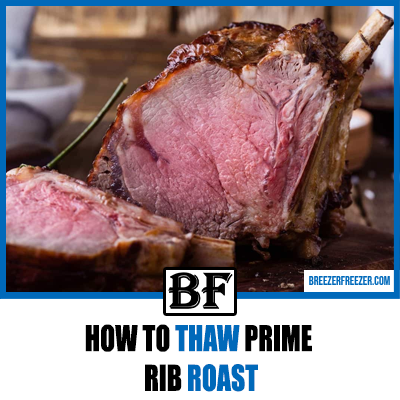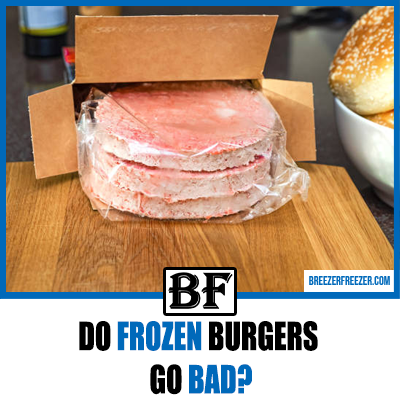How To Thaw Prime Rib Roast
Being one of the most expensive cuts of beef, the prime rib roast can cause a few palpitations when it comes to defrosting it correctly.

Get it wrong, and the beef could be hard in the center tearing the tissues as you try to carve through the prime cut. If you defrost raw prime rib roast, it must be appropriately thawed to ensure thorough cooking.
The prime rib roast is possibly the most succulent of all beef cuts, and it is worth exploring ways to thaw the beef cut that will enhance the flavor and texture of the meat.
Let’s get into it.
Thawing times and methods
Thawing a prime rib roast properly is crucial for a delicious meal. The best method is to thaw the roast in the refrigerator. This will take several days, depending on the size of the roast. For example, a 3-4 pound roast will take about 24-36 hours to thaw, while a larger roast may take up to 4-5 days.
Another method is to thaw the roast using cold water. This is a quicker method, taking about 2-3 hours. However, it is important to keep the roast in a sealed plastic bag to avoid contamination. Make sure to change the water every 30 minutes to ensure that the roast thaws evenly. Regardless of the method used, always use a thermometer to check that the roast is completely thawed before cooking.
Can you thaw prime rib roast in the sink?
You can place the prime rib roast in cold tap water in a clean sink. You may need to place a heavy object on top of the beef cut, so it remains submerged. This will speed up the thawing process.
Change the water frequently, like every thirty minutes to an hour. The water will draw the icy cold temperature from the beef cut.
When the meat thawing is well underway, place it back in the fridge. Beef can turn quickly if exposed to room temperature for more than two hours.
Can you leave the prime rib roast in water?
If you have a large prime rib roast and want to thaw it quicker than leaving it in the fridge, you could place it in a stainless steel bowl and run tap water over the beef for two hours. After two hours, place the beef in the water bowl. This should still increase the thawing time; you can change the water every hour or so if you wish.
Keeping the meat chilled is the key to thawing beef or any meat. Exposing any meat for two hours to room temperature can cause the meat to go bad.
Can you thaw prime rib roast in warm water?
If your prime rib has been vacuum-packed, this is an excellent way to start the thawing process. If the beef is not vacuum packed, then use water that is warm and not hot, it is not going to kill the bacteria, but it will give you a head start.
The warm water will need to be changed every five minutes to speed the process up. After a period of two hours, place the beef cut into the refrigerator and allow it to thaw naturally.
How long does it take to defrost a prime rib roast in the refrigerator?
It will depend on the weight of the cut, and some prime rib cuts can be hefty and take some serious defrosting, which can take days.
Defrost the prime rib in the refrigerator if you are in no hurry. It pays to plan ahead when you intend to prepare such a succulent piece of meat, and often, rushing the thawing process can leave you with lackluster meat.
Beef cuts can thaw quickly. Within a day, if they are of medium weight, just place them on a plate at the bottom of the refrigerator to avoid blood drips and let the meat thaw slowly over the day.
If you have a beef cut with the bone still in the joint, then leave the beef cut to defrost for longer. More significant cuts can take a few days to defrost thoroughly.
It is perfectly safe to leave your prime rib roast refrigerated for five days, and it will not degrade. If you do see a color change, it’s just dryness on the surface and can be sliced off to reveal a juicy beef cut.
How long does it take to defrost an 8 lb prime rib roast?
It will depend on the method of defrosting you select. If you defrost an 8lbs prime rib roast in the fridge, it could take up to 3 days for it to defrost in a fridge that is around 37℉.
An 8lb prime rib is a hefty cut of meat and will require some space in the bottom of the fridge. The idea is to get a cool airflow around the beef cut.
You may need to dedicate a shelf to the beef cut for proper thawing, and don’t forget a large enough plate to catch the blood dripping as the meat thaws.
Best practices for thawing large cuts of meat
Thawing a prime rib roast takes time and care. The best method is to thaw it in the refrigerator. Allow for at least one day of thawing for every four pounds of meat. This ensures that the roast thaws evenly and reduces the risk of bacteria growth.
Another method is to thaw the roast in a sink filled with cold water. Change the water every 30 minutes to keep it cold and prevent bacteria growth.
This method is faster, but requires more attention and can result in the outer layers thawing before the center. It’s important to cook the roast immediately after thawing using this method.
Comparison of the texture and taste of fresh vs thawed prime rib roast
Cooking a prime rib roast that has been frozen can result in a less desirable texture, as the freezing process can cause the meat fibers to break down.
However, if thawed properly, the taste will remain unchanged. Fresh prime rib roast will have a more desirable texture but the taste will be the same.
It is best to thaw slowly in the refrigerator, this is the safest method and will result in the best texture.
Can you leave prime rib out overnight?
Partly. When the thawing process is well underway, leaving your prime rib cut on a countertop for a few hours is permissible. This process is known as tempering the meat, which basically means your beef cut will cook more evenly while the outside of the beef cut becomes nice and brown in the oven.
USDA guidelines state that food should not be held above 33℉ ( 1℉ ) for more than four hours.
Is it OK to leave a frozen roast out overnight?
No, your prime rib roast should be thawed in a refrigerator. Leaving beef on a countertop for two hours or more could see the beef heavily loaded with bacteria rendering the beef inedible.
The USDA issued strict guidance about storing meats and the critical temperature zone at which they should be stored. If the meat is partially frozen, the same rules apply.
How long can you keep an uncooked prime rib roast in the refrigerator?
Dry aging is a popular way of maturing beef. As a rule of thumb, you can keep your prime rib cut for three days. However, beef can be stored dry for three months in a refrigerator.
If you can buy your prime rib vacuum packed, the meat will mature in the pack if kept refrigerated for months on end without degradation to the beef.
Can you cook beef from frozen?
It’s a long process and may not help if you are in a hurry to serve the prime rib roast. Cooking the prime rib roast from frozen will take approximately 50% more time than your standard cooking time.
Some chefs say it is the best way to get a perfectly rare beef cut, while others say it can be disastrous.
Cooking beef cut from frozen may take you through the critical temperature zone that could leave you at risk of food poisoning.
Can you thaw prime rib roast in the microwave?
In theory, yes. It will depend on the beef cut size, but you will need to place the beef on a defrost cycle that can be long. And to be honest, it’s hit and miss, but if you have forgotten all about your guests, you may have no other choice.
Beef with a bone will take longer to thaw in the microwave, which leads to the question: is the microwave intelligent to decode what succulent meat and which is bone? It seems unlikely, and there lies the problem.
Thawing beef in a microwave can be an expensive folly. You see, microwaves work by exciting molecules to heat food. Molecules suspended in ice don’t readily move, meaning the outside of the beef cut will cook while the inside is still a frozen block of beef and water.
Can you cook bacteria out of meat?
You must invest in a decent thermometer to check the meat’s internal temperature. It’s okay for poultry, but when it comes to beef that is eaten rare, it seems as if cooking bacteria out of rare beef may be a hit-and-miss process leaving you susceptible to food poisoning.
Rare beef typically has an internal temperature of 135℉, which is not hot enough to kill the bacteria.
How can you tell if beef has gone bad?
It will smell bad, the smell is the first indicator, and then the texture of the beef will be slimy. If you have beef like this, throw it away.
It may not be such an issue if your beef has turned brown. Aged beef is brown due to the oxidation of the surface of the beef and the blood. It is not an indication your beef has gone bad.
Final thoughts
Planning ahead would resolve the problems of thawing prime rib roasts, but life can take us by surprise, and you have to look for innovative ways to prepare food faster.
The only proper way of defrosting a prime rib roast of a decent size is to let it thaw in the fridge for a few days and then cook.
Alternatively, you could cut down the prime rib roast to manageable portions and freeze pieces individually. This would make the thawing process super fast and convenient.
Microwaving could be a good option, but if you are going to explore this approach, it will only work well if the bone is removed from the beef cut.




